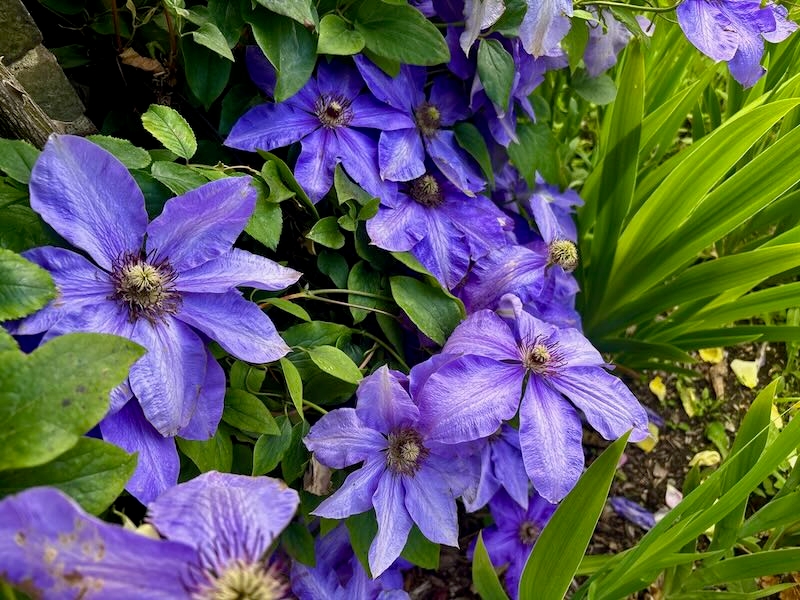Clematis ‘Elsa Spath’: A Heritage Climbing Vine for Stunning Summer Displays
Clematis ‘Elsa Spath’ is a classic large-flowered variety that has charmed gardeners for more than a century. Introduced in 1891 by German breeder Ludwig Späth, this exceptional vine continues to earn its place in modern gardens with its spectacular blooms, extended flowering season, and easy-care nature. Belonging to the family Ranunculaceae, ‘Elsa Spath’ thrives as a perennial climber, adding vertical interest and a burst of vibrant color to trellises, fences, and arbors.
A Closer Look at Clematis ‘Elsa Spath’
This heritage cultivar produces star-shaped lavender-blue flowers that can reach an impressive 15–20 cm (6–8 inches) in diameter. The early-season blooms often display a semi-double form, with overlapping petals for extra texture and depth. As the season progresses, single blooms appear, each surrounding a cluster of deep red anthers that create a striking contrast. These floral displays begin in late May or early June and continue well into September, giving you months of garden color.
After flowering, ‘Elsa Spath’ produces attractive seed heads, adding ornamental value even after the blooms have faded. Its mid-green, compound foliage creates a lush backdrop for the vibrant flowers, though it doesn’t provide notable autumn color.
Growth Habit and Landscape Uses
Reaching 1.8–2.4 m (6–8 ft) in height and spreading 60–90 cm (24–36 inches), Clematis ‘Elsa Spath’ has a dense, twining growth habit that makes it perfect for climbing trellises, obelisks, and pergolas. It also works beautifully for softening fences, wrapping around mailbox posts, or adding vertical dimension to container plantings. When grown in pots, provide a strong support structure for the vine to climb.
This versatile clematis is an excellent choice for cottage gardens, pollinator-friendly plantings, and cut flower gardens. Its lavender hues make it an attractive companion for roses, hydrangeas, or other clematis cultivars with complementary or contrasting colors.
Flowering Season and Pollinator Appeal
Clematis ‘Elsa Spath’ is known for its long blooming period, producing two main flushes of flowers. The first and most abundant display comes in late spring or early summer on the previous season’s wood. A lighter second flush follows in late summer on new growth, ensuring months of color.
In addition to its aesthetic appeal, ‘Elsa Spath’ attracts butterflies, hummingbirds, and other pollinators, adding life and movement to your garden.
How to Grow Clematis ‘Elsa Spath’
Light
Plant Clematis ‘Elsa Spath’ in full to partial sun, ensuring it receives at least 6 hours of direct sunlight daily for the best flower production. While the foliage enjoys sun, the roots prefer cooler conditions. Mulch around the base or plant low-growing perennials to shade and protect the root zone.
Soil
This clematis thrives in fertile, well-drained soils. It tolerates clay, loam, sandy, and silty soils, but heavy clay should be amended to improve drainage. Aim for a soil pH between 5.5 and 7.0.
Watering
Provide consistent moisture, particularly during dry spells. Water deeply about once a week, increasing frequency during heatwaves or when grown in containers. Avoid waterlogging, as clematis roots are prone to rot.
Fertilizing
Feed in early spring with a balanced, slow-release fertilizer or a mix of bone meal and compost. Apply a liquid fertilizer weekly during the growing and flowering season to encourage continuous blooms.
Support
Provide a sturdy trellis, arbor, or other support structure for climbing. Use soft ties to secure young stems as they grow, being careful not to damage the plant.
Mulching
Apply a thick layer of organic mulch, such as compost or bark chips, around the base to maintain soil moisture and regulate temperature. Keep mulch away from the crown to prevent rot.
Pruning Clematis ‘Elsa Spath’
As a Group 2 (Type B) clematis, ‘Elsa Spath’ requires light pruning. In late February or early March, remove any dead or weak stems and cut back remaining growth to a pair of strong buds about halfway down the vine. This method encourages vigorous growth and ensures both early and late-season blooms.
Propagation
Propagate Clematis ‘Elsa Spath’ through semi-ripe cuttings taken in midsummer or by layering. For layering, bend a healthy stem to the ground, secure it with a pin, and cover the node with soil until it develops roots, then sever and transplant.
Pests and Diseases
This cultivar is known for its resistance to deer and several common garden pests. However, it can occasionally be affected by clematis wilt, powdery mildew, or aphids. To prevent disease, maintain good air circulation, avoid overhead watering, and remove any infected foliage promptly.
Environmental Tolerances
Clematis ‘Elsa Spath’ performs well in USDA zones 4a–9b. It is tolerant of heat and humidity, making it suitable for a wide range of climates. Its deer resistance makes it a reliable choice for gardens in rural or suburban areas.
Final Thoughts
Clematis ‘Elsa Spath’ remains a gardener’s favorite for its large, showy flowers, repeat blooming, and reliable performance. Whether climbing up a trellis, cascading over an arbor, or enhancing a container garden, this heritage cultivar continues to prove its value in landscapes more than a century after its introduction.



